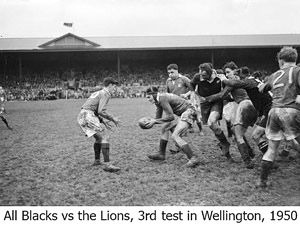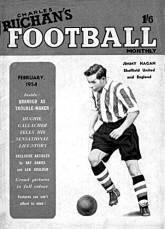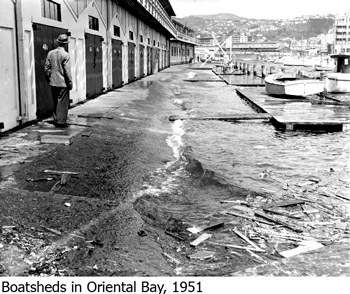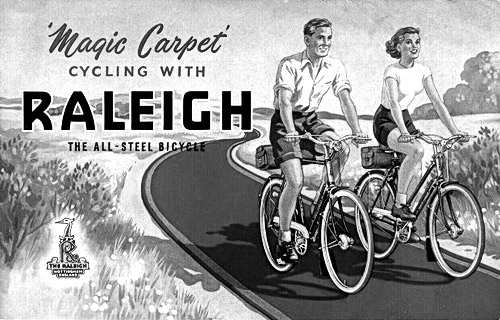Sample chapter from Playing Against the Wind
Playing
against the odds
 The
year I decided to play for the All Blacks was a bad one for teddy. It was
1950 and the national team was going head-to-head with the touring Lions. I
acted out several of the matches on the living room carpet. Not having a
ball, I drop kicked, place kicked, passed and rucked my faithful, blameless
teddy while the legendary Winston McCarthy bellowed his commentary over the
radio. The head of he who had been for so long my close friend and
confidant, stayed on and, even when he lost a leg in ruck, his glass eyes
revealed not a hint of reproach. I can still remember stepping deftly
through the Lions’ defences before flicking teddy to our winger, Roy Roper,
who duly went over for the try. The
year I decided to play for the All Blacks was a bad one for teddy. It was
1950 and the national team was going head-to-head with the touring Lions. I
acted out several of the matches on the living room carpet. Not having a
ball, I drop kicked, place kicked, passed and rucked my faithful, blameless
teddy while the legendary Winston McCarthy bellowed his commentary over the
radio. The head of he who had been for so long my close friend and
confidant, stayed on and, even when he lost a leg in ruck, his glass eyes
revealed not a hint of reproach. I can still remember stepping deftly
through the Lions’ defences before flicking teddy to our winger, Roy Roper,
who duly went over for the try.
I was eventually given a real rugby ball as a Christmas present. Sadly, this
long-anticipated acquisition did not turn out to be the spark that ignited a
distinguished rugby career. I was on the back foot from the start.
The first hurdle I faced in my path to rugby glory was the topography of our
back lawn. It was some eight square metres in area, triangular in shape and
on about a 45° elevation. There I practiced kicking, using the clothes line
as the height objective. The process was fraught with peril. Kick too high
and the ball went over the fence and into the town belt scrub; too low meant
leaving a dirty mark on whatever was on the clothes line. And any kick that
rebounded backwards toward you was in danger – thanks to the unpredictable
bounce – of either flattening a sub-section of what my father fancifully
called the vegetable garden, or of finding its way into the near
impenetrable jungle at the side of our house where, quite possibly, a lost
Māori tribe still lived.
On occasion I got to practice with my friend Ken Grant on his lawn, which as
I recall was L-shaped, small, but was at least flat. Ken was a year younger
than me and already developing the build which would see him play as a
forward for the Junior All Blacks. I was developing the build which would
see my rugby career peak as fullback for the Evening Post social XV:
Played: 6
Won: Against pitifully weak opposition only
Lost: Usually
Somewhere in the early 50s I lost my faith – in rugby. It was Roseneath
School’s fault. All of its playing areas were paved in asphalt or concrete
and rugby was a banned activity. We played soccer, usually with a tennis
ball because the abrasive surfaces would have destroyed anything made from
leather – and probably because the school’s pitiful armoury of sports
equipment didn’t include a leather ball anyway.
There may possibly be some parts of Terra del Fuego where the
wind blows more strongly than it does at the promontory to which Roseneath
School is nailed, but I doubt it. Trying to dribble a tennis ball upwind and
through a forest of opposing legs in those conditions probably taught us
quite a lot about ball control. Bit by bit, my enthusiasm for rugby waned.
And then Albert Quixall effected my permanent conversion to the round ball
code. I had come across an English soccer magazine called Charles Buchan’s
Football Monthly, which contained an article about Sheffield Wednesday, who
at the time that particular issue went to press, were about to play the 1954
FA Cup semi-final against Preston North End. One of Wednesday’s strikers was
Albert Quixall, who was in the vanguard of football fashion. He wore his
shorts very short when everyone else’s reached almost to the knee and he had
ankle-high ‘Continental’ boots when the rest of the English soccer world
wore clod-hoppers. I was hooked – on cool Albert and on Sheffield Wednesday.
 In
those days New Zealand newspapers showed little or no interest in UK soccer
and I had to wait for the next month’s edition of Mr Buchan’s splendid
publication to discover Wednesday had lost. For the ensuing half century I
have opened newspapers to learn that – more often that not – Wednesday have
lost. In
those days New Zealand newspapers showed little or no interest in UK soccer
and I had to wait for the next month’s edition of Mr Buchan’s splendid
publication to discover Wednesday had lost. For the ensuing half century I
have opened newspapers to learn that – more often that not – Wednesday have
lost.
It would not just be stretching a long bow to suggest that Roseneath School
was, in today’s terminology, a cradle of sporting excellence; it would be to
give credence to the patently absurd. There were only about a hundred of us
at the school from which to select sports teams – including the halt, the
lame and members of the fairer sex. There were no videos, films or books of
instruction to guide ardent young sportsmen and women – let alone coaches.
You learnt by imitating the older kids, or least those of them not fitted
with two left feet. Our threadbare ranks meant that if you were male and had
a pulse, your membership of the school’s soccer/and or cricket teams was
assured. It also meant that our results against other schools were a
foregone conclusion.
The first away game I can remember was against Brooklyn School. When the
jerseys were handed out I was mortified to discover they were woollen, had
leather lace up necks and had obviously been providing hearty fare for a
colony of moths for some years. These dreadful garments apparently went back
to the dim distant days when the school fielded a rugby team – probably
about the time Kaiser Bill decided to retire from the real estate business.
I and a few others of the team for whom appearance was of some importance
rebelled and said we’d play in what we stood up in (which in my case
included mother’s home made grey flannel shorts and a deceased great uncle’s
argyle socks). The remainder of the team donned their faded grey-and-red
hooped relics and thus arrayed, the Roseneath soccer team, all hopes of
being taken seriously by the enemy abandoned, sallied forth.
In these days when school children seldom move anywhere except with
motorised escort, it must sound somewhat far-fetched that we were despatched
without the accompaniment of a teacher – let alone parents. We had a
reasonable idea of which buses and trams would get us to the ground –
somewhere we thought was called Tanny-ra (Tanera, actually) Park to lock
horns with the pre-adolescent youth of Brooklyn. The ground, when we got
there, turned out not to have goal posts, let alone white lines. Brooklyn at
least possessed a teacher, parent or guardian who supervised the strategic
placement of jerseys, coats and school bags where posts and corner flags
should have been and with the ground thus ‘marked’ out, battle began.
We lost.
About this time I began an infatuation with the Stop Out soccer club of
Lower Hutt. Trust me to get tied up with another club with a silly name. At
least the Stop Out team of those days made a habit of winning quite
regularly, in conspicuous comparison with most of the teams I’ve supported
down the years. So every day for the last couple of years I was at school, I
wore my red-and-yellow Stop Out ribbons and, most days, had shin pads tucked
inside late Uncle Charlie’s socks.
In the summer of course it was cricket. Again the Martins’ back lawn proved
a serious impediment to practice. I’d throw a tennis ball at the steps at
the apex of our triangle of grass with my right arm, while holding the bat
with the left. With the ball released I would quickly wrap my right hand
around the handle, wait for the returning projectile to bounce, and then
attempt to play it. Shot selection was limited by the fact that a cover
drive meant damage to the carnations, an on drive menaced the wallflowers
and both cuts and glances risked a 10 minute search for the ball. Thus, with
the bounce always unpredictable, I became a back foot player of straight
drives. I also became skilled at blaming the cat’s sleeping habits for
injustices done to the carnations.
Tennis practice was similarly handicapped. My solo rallies seldom lasted
more than two shots before the ball sailed over the fence or down the bank.
My racquet didn’t make things any easier either. It had belonged to my
mother, had a wooden handle and was about the vintage of the Roseneath
School football jerseys.
I rather fancied myself as a boxer. The local welterweight Barry Brown had
New Zealand enthralled at the time and I saw myself as his logical
successor. Sadly my career as a pugilist failed spectacularly to meet my
expectations.
A year or so prior to my decision to be Barry Brown’s understudy, my father,
believing I needed to learn how to ‘stand up for myself’ should the occasion
arise, had decided to teach me to box. I had long since concluded that, with
a body which looked like it was in the grip of some awful wasting disease
and the ability to run like the wind, flight was the answer to the
possibility of confrontation with any but the most physically short-changed.
But gloves were duly purchased and lessons commenced. They didn’t last long.
After some timid and easily-deflected pokes in my father’s direction I was
told, “That’s not boxing. Punch as if you mean it.” Always keen to oblige I
took a swing at his nose. Direct hit. The bombarded proboscis bled profusely
and there ended the first (and only lesson).
The gloves came out again when Barry Brown sprang to prominence, but this
time my opponent was the kid in the mirror which hung the hall. He was lithe
and lightening fast, but despite that I won every fight by a knockout.
I finally got to face a flesh-and-blood opponent in the third form at
college. It was in a Phys. Ed. session and I was drawn to face Denys Sumner.
He was one of the smallest and least fearsome boys in the class. A massacre
looked inevitable. But when the bell went and I looked across the ring to
the opponent I was going to obliterate, I saw that such were his dimensions,
virtually all of his hittable bits were hidden behind his gloves.
Nonetheless I leaped forward, flaying hopefully, but without inflicting any
discomfort whatsoever on my opponent. He then moved inside my spidery
forearms and pounded away at my mid-section. Before then, I had never given
any thought to someone hitting me. I retired from the ring at the end of the
bout.
My love affair with fishing lasted much longer. Making my way from our house
to the boat harbour on Saturday mornings with nylon line, hooks, sinkers,
bread for slush (now called burley) and bacon rind for bait, I personified
hope – which as Dr. Johnston rightly said, is perhaps the greatest happiness
this world affords. It’s that wonderful sense of anticipation – no,
expectation – which keeps fisherman coming back for more. Over the years my
strike rate has been woeful, but I retain a touching faith that the next
cast will do it.
 I
and my friends had modest aims as fishermen. We were after the grey mullet
(we called them herrings) that teemed in the sheltered waters of the boat
harbour, or trevally, which appeared infrequently, or the occasional
mackerel lacking the self respect to hunt in deeper waters. I
and my friends had modest aims as fishermen. We were after the grey mullet
(we called them herrings) that teemed in the sheltered waters of the boat
harbour, or trevally, which appeared infrequently, or the occasional
mackerel lacking the self respect to hunt in deeper waters.
It was while fishing in the boat harbour, just a few metres from where today
chefs labour to gain the approval of gastronome guests at Martin Bosely’s
restaurant, that I entered the food industry myself.
It happened this way. The most-caught fish were spotties, but for some
reason, we disdained them. We took them off our hooks and tossed them onto
the wharf to complete their shuddering demise. As I mentioned, slush, made
by soaking stale bread, was thrown onto the water to attract the herrings.
It was an effective strategy, but the bread eventually and inevitability ran
out.
The building behind our fishing spot had been left there, like at least two
of my contemporaries, by the Americans. I believe it housed the officers’
quarters. A pipe emerging from the bowels of this building spewed out a
continuous stream of scalding water. I hit upon the idea of gathering up the
deceased spotties and putting them under the pipe till the hot water cooked
them. They were then mashed up and thrown into the water as a high-protein
substitute for bread. Cannibalism being firmly established in the world of
fish, I felt no moral twinge. Nor, for that matter, did the herrings. I
thought a nomination for a Nobel Prize of some sort was in order but sadly,
it was not to be.
My collection of herrings went home to be offered to our cat, Frankie, who
once ate 20 of them at a sitting. Admittedly, they were small and Frankie
wasn’t. But 20 herrings surely should have short-listed him for the Guinness
Book of Records.
For years I harboured dreams of owning a bicycle. Advertisements in English
magazines for cycles branded Rudge, Raleigh and BSA pictured happy cyclists
wheeling down English country lanes, waving to cheerful rustics as they
pedalled towards some Arcadian destination. Such images left me longing to
enter that Enid Blyton fantasy world.

Eventually, one blessed birthday, my wish was granted. Well, sort of
granted. These days, bikes for the young come from either from specialist
cycle shops, chain stores or at very worst, are purchased second hand
through the web.
Mine came from the tip – most of it anyway. My father added bits from here
and there to a frame he had found at the Karori Landfill and then painted
his creation jet black. All over. Frame, rims, everything but the spokes. It
was a true bitser. It had only one brake – operated by reversing the pedals.
In fact brake was a misnomer. It was a device for reducing the rate of
forward velocity. There was no carrier, no place for a pump and no gears.
The first weekend I had it I went for a long ride, in the company of Johnny
Edmundson whose parents were so fabulously rich that they had bought him a
proper bike with more than one colour and a badge that read BSA. Without
having the slightest knowledge of the road code and no crash helmets, we
rode some 25 kilometres around the Marine Drive and returned to tell the
tale.
A couple of years later I got my first real bike, a Raleigh, with hand
brakes and three gears – too low, middle and too high. The old machine went
back to the tip. Ashes to ashes.
|
 The
year I decided to play for the All Blacks was a bad one for teddy. It was
1950 and the national team was going head-to-head with the touring Lions. I
acted out several of the matches on the living room carpet. Not having a
ball, I drop kicked, place kicked, passed and rucked my faithful, blameless
teddy while the legendary Winston McCarthy bellowed his commentary over the
radio. The head of he who had been for so long my close friend and
confidant, stayed on and, even when he lost a leg in ruck, his glass eyes
revealed not a hint of reproach. I can still remember stepping deftly
through the Lions’ defences before flicking teddy to our winger, Roy Roper,
who duly went over for the try.
The
year I decided to play for the All Blacks was a bad one for teddy. It was
1950 and the national team was going head-to-head with the touring Lions. I
acted out several of the matches on the living room carpet. Not having a
ball, I drop kicked, place kicked, passed and rucked my faithful, blameless
teddy while the legendary Winston McCarthy bellowed his commentary over the
radio. The head of he who had been for so long my close friend and
confidant, stayed on and, even when he lost a leg in ruck, his glass eyes
revealed not a hint of reproach. I can still remember stepping deftly
through the Lions’ defences before flicking teddy to our winger, Roy Roper,
who duly went over for the try. In
those days New Zealand newspapers showed little or no interest in UK soccer
and I had to wait for the next month’s edition of Mr Buchan’s splendid
publication to discover Wednesday had lost. For the ensuing half century I
have opened newspapers to learn that – more often that not – Wednesday have
lost.
In
those days New Zealand newspapers showed little or no interest in UK soccer
and I had to wait for the next month’s edition of Mr Buchan’s splendid
publication to discover Wednesday had lost. For the ensuing half century I
have opened newspapers to learn that – more often that not – Wednesday have
lost. I
and my friends had modest aims as fishermen. We were after the grey mullet
(we called them herrings) that teemed in the sheltered waters of the boat
harbour, or trevally, which appeared infrequently, or the occasional
mackerel lacking the self respect to hunt in deeper waters.
I
and my friends had modest aims as fishermen. We were after the grey mullet
(we called them herrings) that teemed in the sheltered waters of the boat
harbour, or trevally, which appeared infrequently, or the occasional
mackerel lacking the self respect to hunt in deeper waters.
